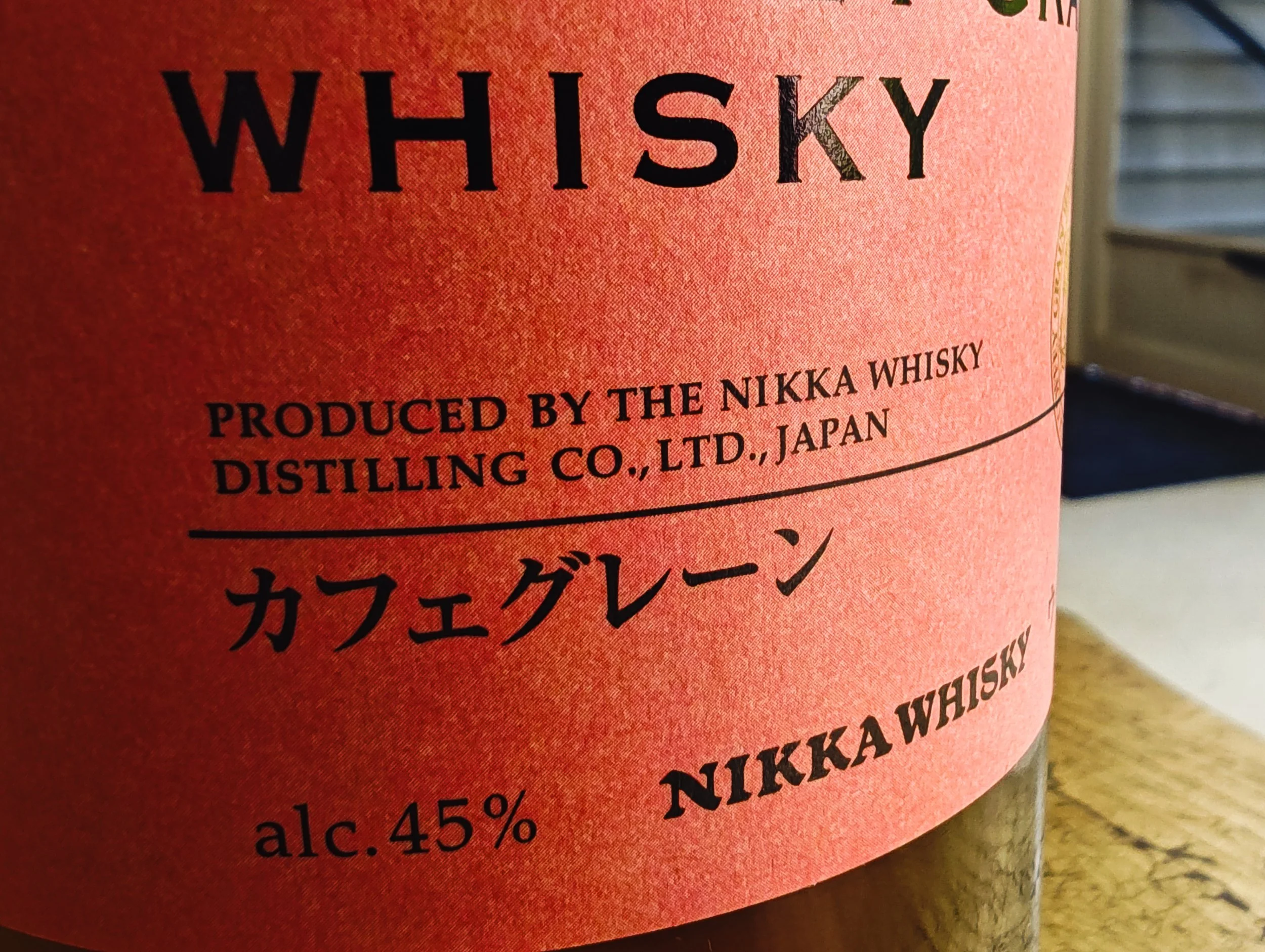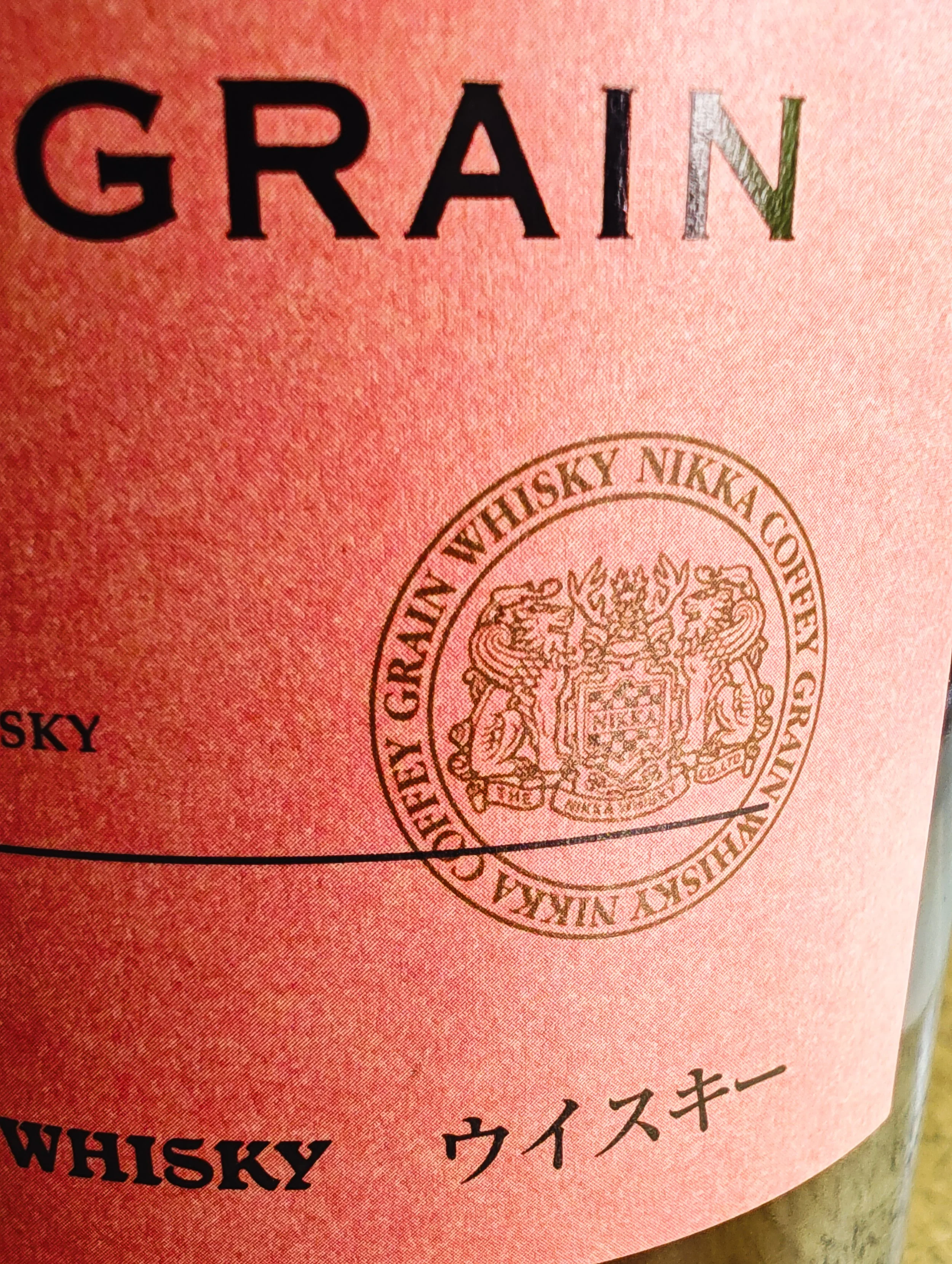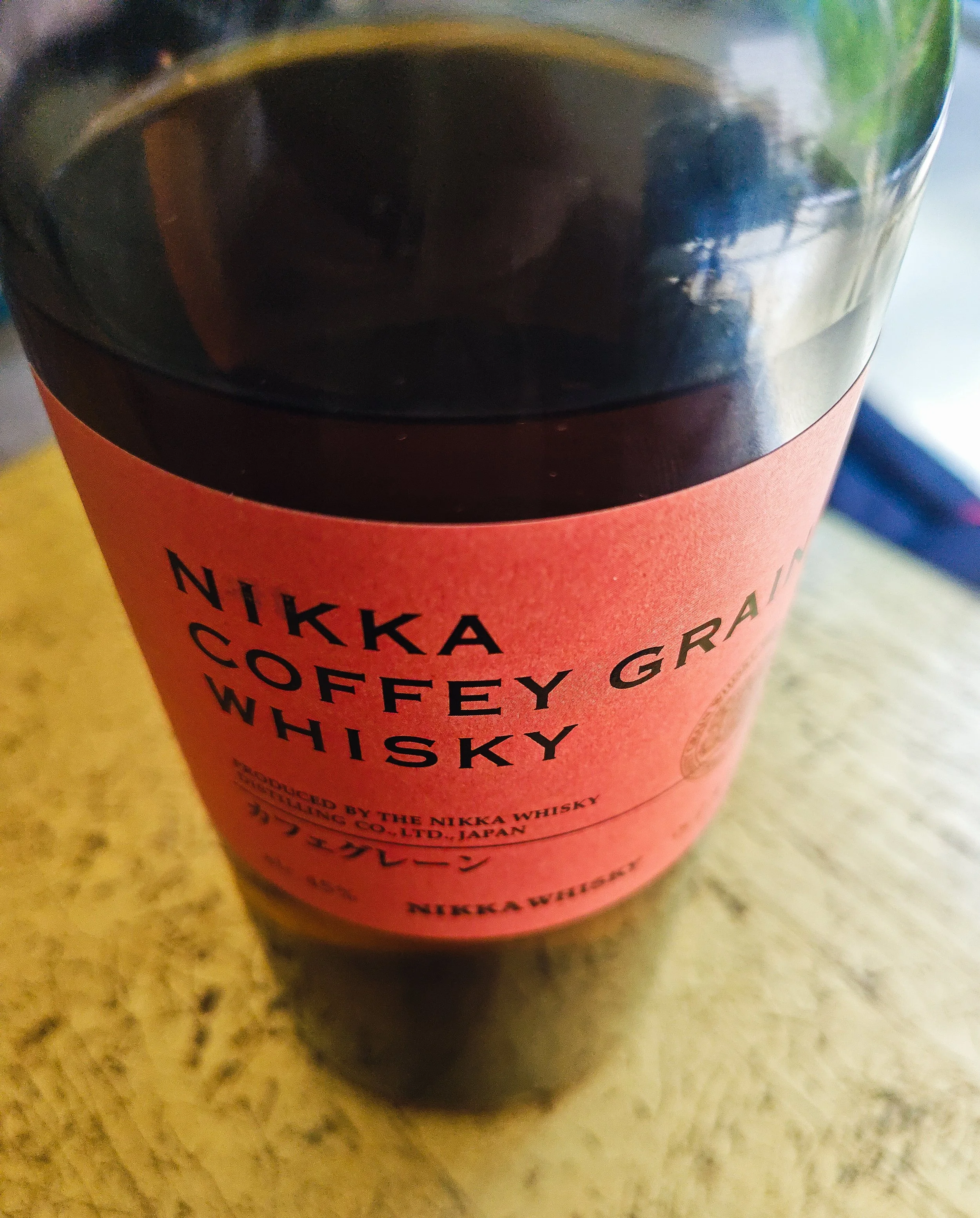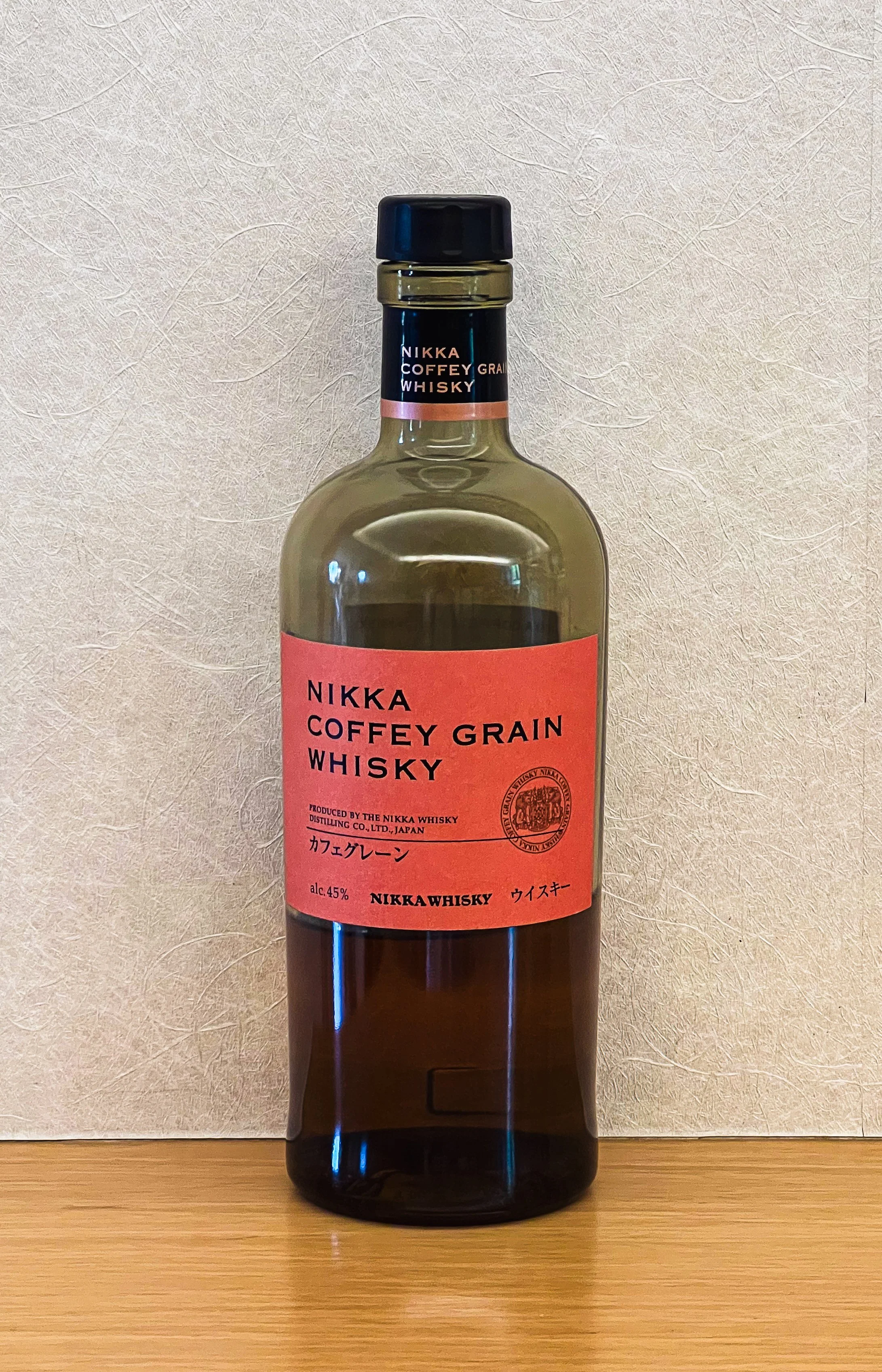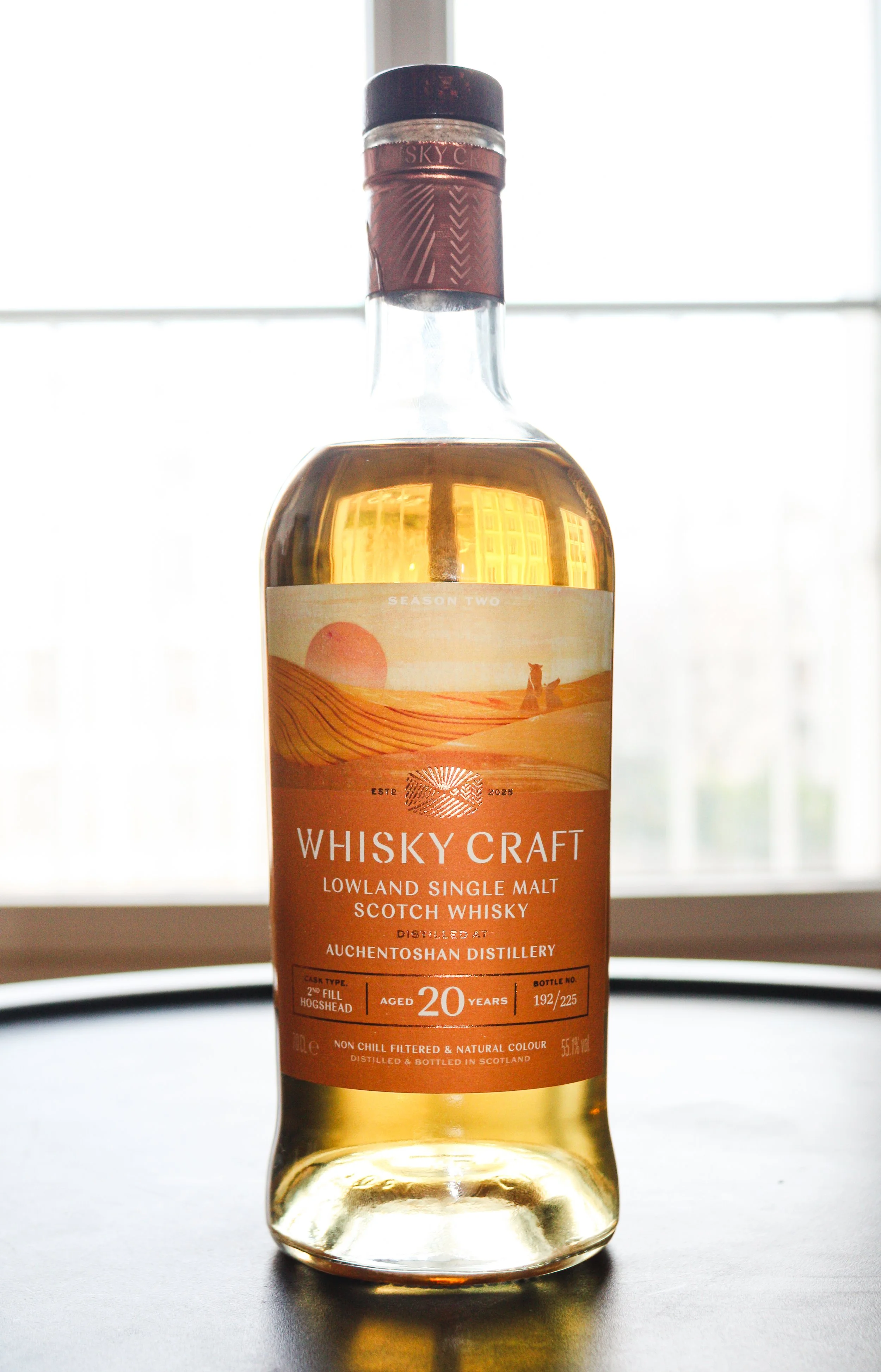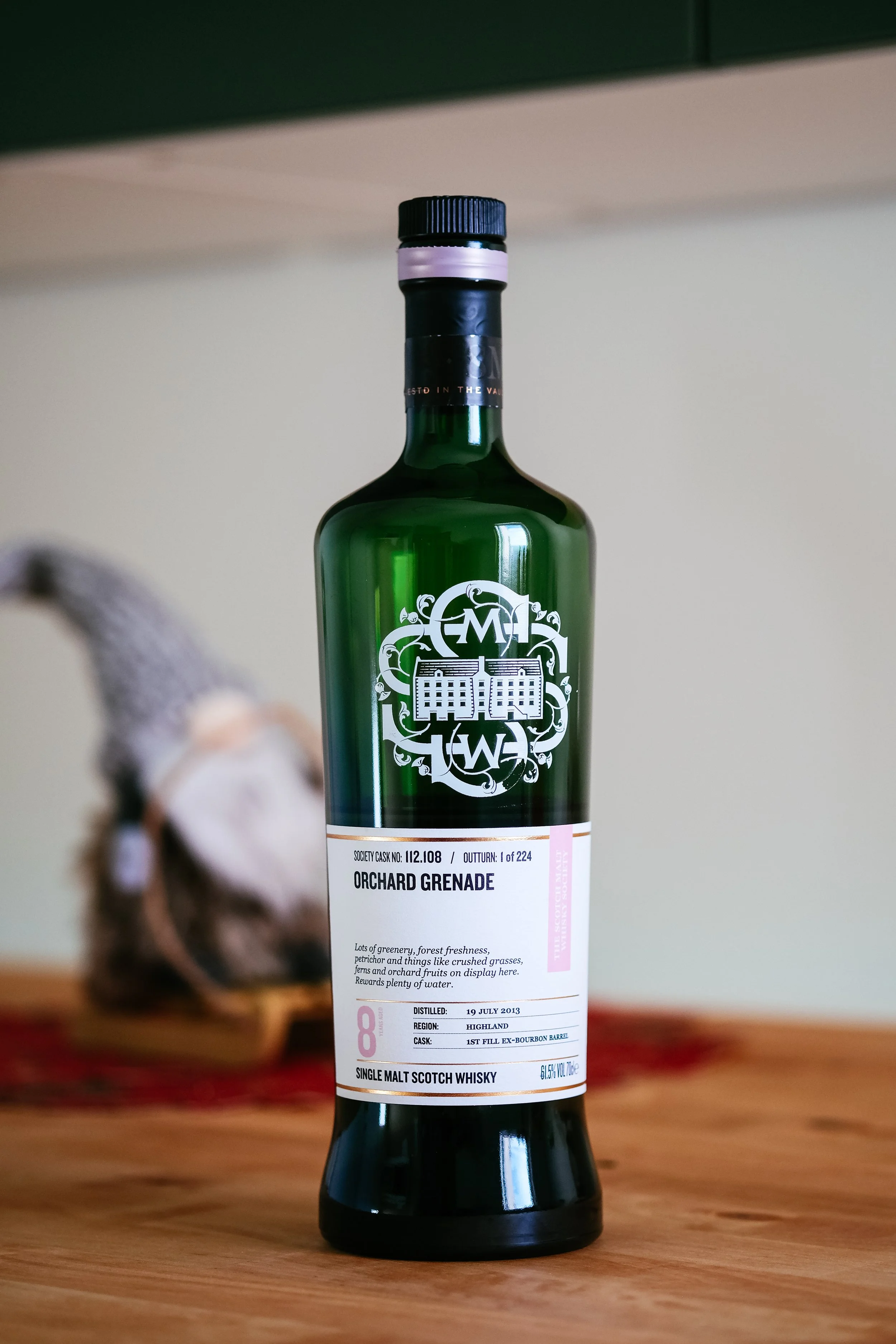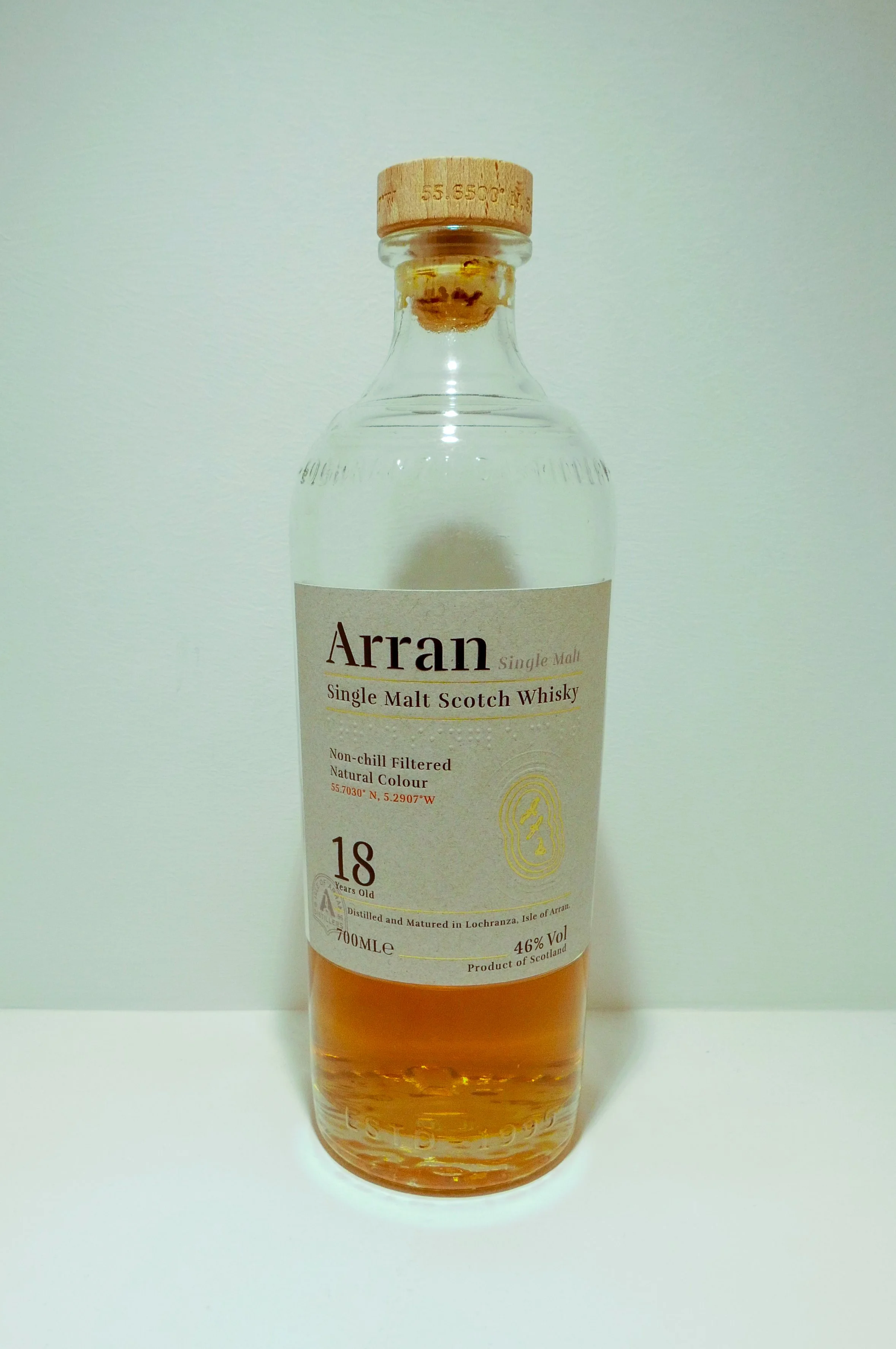Nikka Coffey Grain
Japanese Grain Whisky | 45% ABV
It’s fine. Just fine.
Oftentimes I feel as if I am perpetually falling behind my whisky comrades and brethren.
Since moving to North Carolina, the malts available to me are hardly expansive. In fact – other than the Johnnie Walkers, and lowest age-stated OBs of Glenfiddich, Glenmorangie, etc. – they are very sparse. So, when the Dramface Colonials started to talk about doing another collaborative review, my heart began to sink a bit, wondering if I could source a bottle in time for the effort.
Some expressions were discussed, and among those suggestions a humble and often overlooked Japanese bottle was tossed about. And then…an old adage became reality. You’ll often hear us say that “whisky finds you.” Indeed, my ability to contribute to this review is yet another example that this adage is accurate.
In my milieu here in North Carolina, the dreaded ABC system is in place. The State tells you what it will sell to you. And, let me tell you, the State of North Carolina either doesn’t like malt and grain whiskies or doesn’t know of them. Despite this, I still periodically visit each of my local ABC stores – usually one ABC store per town.
Between my home and work, for example, there are four towns and five ABC stores. The stores all have 99% of the same whiskies, but there are one, two or three different bottles differentiating one ABC store from another. It ain’t much… But I play the cards that are dealt to me.
And so, on a lark, on my way home one evening, I diverted from my usual route to get to one of the ABC stores between work and home. I don’t often get to this particular ABC store, and as I walked down the very short aisle of Johnnies and Glen-beiges, I realized that there was nothing new on these “Scotch” shelves. To get to the exit, I had to turn and walk down the “Canadian/Vodka” aisle. It was a bit of kismet as, after walking past a number of Canadian Mist, Seagram’s VO, and Alberta Premium bottles, there – before the allotment of vodka bottles – were three bottles of Nikka Coffey Grain.
I’m not sure if the good folks at that ABC store think that Japan is a less well-known province of Canada or if they simply weren’t sure if “Coffey Grain” was its own category, or if this was a joke - but there they were. I was elated to find, here in the whisky desert, one of the bottles that were being bandied about as a collaborative option.
I believe I have had a dram of this in years past, but I genuinely had no recollection of the whisky itself. And so, into the cart it went . . . Albeit with a wince after looking at the price.
That said, and though perhaps unfair, I had a preconceived notion as to what I would find in this bottle. Between the very spartan, neat, minimalist label and knowing this was a Japanese whisky, I felt confident that I would be far astray from a Scottish whisky experience.
To be clear, Scottish whiskies are known for, and properly celebrated because of, batch variation. As Scottie mentioned in a past Dramface podcast regarding Johnnie Walker bottlings, and as I documented in my recent Bunnahabhain 12 review, releases over the span of five to ten years often vary significantly. I believe that, absent the behemoths of Glenfiddich, Glenmorangie, and a few others, Scotch whisky expressions will vary over a relatively short span of time. Whether this is due to cask availability, depth of stocks, or other factors, I cannot say. I must say, however, that I love batch variation. I love a few edges, bumps, some imperfections, and character. Those aforementioned behemoth “Glens” are, in their pursuit of consistency, often overly polished and relatively uninteresting in my view.
Review 1/3 - Ogilvie
Nikka Coffey Grain, Japanese Grain Whisky, Official bottling, 45% ABV
USD$75 paid (£55) and wide availability
As I opened this bottle, I thought about this Nikka expression and had some concerns about it being a Japanese version of the behemoth “Glens”. Perhaps unfairly, I reflected on the brilliant, exacting, and consistent means by which the Japanese are known to create all manner of things from watches to automobiles, and to whisky. As such, thoughts lead me to think this whisky will be incredibly engineered, smooth, and refined to the point of a loss of character. No doubt wholly pleasant, but… engineered.
I hope I’m wrong.
Score: 4/10
Some promise.
TL;DR
Something that’s a little too rounded out and ‘engineered’
Nose
The initial waft makes me think of bourbon, not far from the Uncle Nearest 1856 that is in my bourbon cupboard: vanilla icing from the supermarket. Behind the vanilla, some sencha green tea. Cucumber peels. Casaba melon.
Palate
Sweet and, dare I say, an engineered smoothness. Even without reading the label on the bottle, anyone with a little experience between Coffey and pot stills would know this is not a pot still expression. Coffey still fingerprints are all over this. Viscous and pleasing on the tongue as well as with the mouthfeel. It takes me a few seconds to parse out different flavours. Dried and candied mango. A bit of nougat and toffee. Artificial vanilla. A hint of orange marmalade which brings a bit of sweet and bitter. There is a warmth that comes to my tongue mid-palate. After the warmth comes, the finish drops off rather quickly. With the initial mouthfeel, I was hoping for a longer finish.
During and after the finish, I still get the sense of, and flavors to, a lower-proof bourbon. Corn sweetness with some vanilla.
Each time I go through the dram in my glass I am still left with a feeling that this whisky has been overly refined. In woodworking terminology, it has been sanded down to feel like glass.
The Dregs
As is my custom, I don’t start looking online for information about a bottle until after I do my nosing and tasting. And, that information search is done only if I can’t find information on the bottle. The bottle in question, as noted, is spartan and devoid of any information other than (1) ABV, and (2) this whisky is a grain whisky, and (3) that it has been run through a Coffey still.
It is encouraging that I find in my online research that this bottle is, in effect, a bourbon. It has a mashbill of 95% corn and 5% malted barley. That matches what I am experiencing on the nose and in the tasting notes. The 95% corn mashbill may put off those who are squarely in the single malt lane. The corn sweetness, though rounded and smoothed by the Coffey still, remains. If you wish for malty or salinity or funk or leather or smoke or stewed stone fruits, this is not for you. More to the point, if you are someone who can lean into a classic bourbon recipe and also appreciate a whisky with no edges or ridges of any kind, then this may be something for you.
I also learn in my online reading that this expression – while NAS – is supposedly made up of 8 to 12 year old whisky. I believe this contributes to the fact that this whisky has no edges. It isn’t a young whisky which would bring edges to the party. The 8-12 year range makes sense with what I am experiencing.
My pre-conceived notions are borne out, and also not. This whisky is so very mellow and – dare we say – smooth. As said, it has no edges. It is rounded like a circle. But, like a circle - as opposed to a sphere - it has no depth.
While I appreciate the effort to engineer toward a would-be perfection of a glass orb, my particular interest in whisky is found in a distillate’s character. My lane, generally, is richer and bolder, oily and flavorful. The whisky in my glass is fine. It is good. Nothing here is bad, but there is nothing interesting. As for assigning a score, I was teetering for a very long time between a 4/10 and 5/10, to be quite honest. A coin flip, in all reality.
And, not to kick this while it may be down, spending $75 USD on this bottle is a regret.
Even with all of that negativity, it is still an experience that I am glad to have had. The experience, however, is a whisky that has been engineered so well it has lost any interesting bumps, warts, and character - and that is not something to celebrate in my view.
Score: 4/10 OS
Review 2/3 - Murdo
Nikka Coffey Grain, Japanese Grain Whisky, Official bottling, 45% ABV
HKD$650 paid (£61) and wide availability
I have a buddy who is a board game guru, much in the same way that I’m a whisky freak. He also happens to dabble in whisky, so usually when we get together to play board games, we also sip whisky, and these two things are actually quite a good match.
The games we tend to play are the brain-eating type; one game can take three hours or more, and one single turn can take a few minutes. So, with a four-player game for example, there can be 10 minutes between turns. During those 10 minutes, you would be observing what others are doing, all the while formulating your own strategies, so that when your turn eventually comes, you already have a sense of what you might be doing.
However, half of the time, the previous player would have done something to make you rip your plan apart and think of a new one on the spot, hence taking a few minutes. During those 10 minutes, I often also do something else - I sip whisky. With the session being a board game session, not all present need to be interested in whisky, in fact, usually only my buddy and I would be drinking, but the structure of this social thing facilitates thoughtful whisky sipping.
I first came across the Nikka Coffey Grain during one of these sessions when he pulled it out of his stash, he also had the Coffey Malt still sealed, so we sipped this one instead. As he poured me this whisky, he introduced it: “There’s a way that they make whisky in Japan, so that there’s a coffee note to it, try it, it’s pretty cool”.
Now before you pass judgment, someone having a misconception doesn’t equate to them being ignorant or stupid, he was simply relaying information he was told and didn’t question it. In all honesty, I also hadn’t noticed anything wrong, this was several years back and I had also just gotten into whisky; I knew about continuous stills, but I didn’t know about Aeneas Coffey or his specific stills, so I sipped along, but I just couldn’t find that coffee note that he suggested, even the power of suggestion couldn’t do its thing.
A few turns into the board game and a few sips of the whisky later, I took a closer look at the bottle. First, it’s spelt Coffey, not coffee; then, there’s the information at the back of the bottle, there’s a small drawing of a Coffey still, and a little information on how Nikka had imported this rare patent still in the 1960s, producing a mellow and sweet whisky originating from the grain.
So there it is, it’s Coffey, not coffee. Of course, we’re in the middle of a competitive board game session, and things are about to get heated, with two other participants who have absolutely no interest in whisky, this is a small mistake from my buddy, and I would have a word with him afterwards, for then, I kept sipping the whisky.
During this "gotta catch 'em all" phase of whisky exploration, I went out and bought myself the pair of Nikka Coffey whiskies, and have since rinsed both of them. I decidedly liked the malt version better, so I replaced that one and left the grain version. Until now.
When the colonials started to talk about another collaboration review - in fact it was me who brought it up, I narrowly missed out on the Baker’s review and I was a bit sour - we explored several options, accessibility is always an issue because of the quirks of global distribution. We could have gone for something ubiquitous like a Glenfiddich 12, but we wanted something a bit more interesting, so we started throwing around names of whiskies that we have access to, and the Nikka Coffey Grain was suggested.
Secretly, I wished the group had picked the malt version, but since a few of us already have the grain, and I knew how difficult it was for some of us to get the malt, I went out to get myself a bottle of this. A bit begrudgingly, I thought it was a bit expensive at the equivalent of £61, and annoying at the same shop I could get the Yoichi NAS at £56, but I told myself, this is for the greater good…
Score: 3/10
Disappointing.
TL;DR
Useful as blending component perhaps, less enjoyable neat
Nose
Solventy, there’s no getting away from that; hints of vanilla, bananas, orange peel, that’s about it.
Palate
Vanilla is at the centre stage, the texture is rather creamy, buttery even, which sums up the arrival. The orange peel from the nose makes its appearance in the development, which adds a bit of bitterness to the taste, it does feel that there’s a melon note trying to push its way through, but not quite. So far, so solventy though, I keep thinking nail polish remover even though I haven’t smelled that in years, maybe white rum would be a more apt descriptor. The finish, with the bitterness and vanilla dangling, is expectedly short.
The Dregs
Let’s first try to address the mash bill of this whisky. From what I can gather on the internet, this is 95% corn and 5% malted barley, which means bourbon drinkers would be expected to find a lot of familiarity here, minus the new oak.
From the tone of my notes, you’d probably fathom that I didn’t enjoy this very much, and you would be right. From the nose to finish, the solvent note is way too prominent, but is it masking anything? Possibly also not, it’s just flat. I remember liking this more when I first had a bottle, which has been three years ago, maybe it’s batch variation?
When I tried the sorghum whisky from Taiwan I suspected that the slow maturation of maize or corn based spirits had the potential to bring a new perspective to whisky: this, however, is quite the opposite extreme.
I suspect this whisky has been aged in tired casks, so much so that it could be closer to new make than to a whisky mature enough to hit the market, and yet here it is. Perhaps a finish in virgin oak could make this a lot more palatable? If you’ve tasted bourbon new make, perhaps you’d be in a better position to comment?
For me, this is only good as a blending component, it’s not really for sipping neat.
Score: 3/10 MMc
Review 3/3 - Eallair
Nikka Coffey Grain, Japanese Grain Whisky, Official bottling, 45% ABV
USD$53 paid (£42) and wide availability
This whiskey occupies a special place in my mind.
It's hard to explain though, so I’m going to use some stage props to demonstrate what I mean…
Imagine. You’re on vacation in a quaint, old-timey Kentucky town, tucked away in the mountains of Appalachia. You find an old and cluttered antique store and decide to step in. You walk past the front register and make quick pleasantries with the cashier - an older guy who speaks with a hard southern drawl. You meander about and stroll up to an old tube style TV in a rustic wooden case. It suddenly flickers to life. The lights above you blink and buzz. Startled, you stop to stare as the screen fades in, and vacuum tubes begin to hum and the black and white visage of outer space comes into view. Rod Sterling’s voice emits from the crackling mono-speaker:
“There is a 5th dimension, beyond that which is known to man. It is a dimension as vast as space and timeless as infinity. It is the middle ground between Light and Shadow, between Science and Superstition. And it lies between the pit of man’s fears and the summit of his knowledge. This is the dimension of imagination, it is an area which we call, "The Twilight Zone.”
You look down and glance at your hands. You’re holding a simple, demure shaped bottle of smoked coloured glass. On the label reads, NIKKA COFFEY GRAIN WHISKY. Stunned, you run outside. It’s hot and muggy. You squint in the glare of the sun to see the familiar Kentucky storefronts - until you suddenly notice - the signs are all printed in Japanese script. The cars are all Toyotas and Hondas. Things look familiar, and eerily not at the same time.
Startled, you run back inside and notice the cashier is no longer the same roly-poly, bespeckled and suspendered old man. He’s… Japanese? The cluttered old antique store is now clean and orderly.
This whisky, or should I say Japanese Bourbon, is exactly like that fictional scenario above. I love this whisky for what it is. An enigma. The unexpected result from the cross-contamination of two cultures. Yes, this whisky has its own factual story - you know the one with Masataka Taketsuru, the Godfather of Japanese Whiskey, the opening of the Yoichi distillery in Japan, and so on. It’s a cool story and readily available on the YouTubes. Kanpai Planet’s got a great little intro that’s well worth checking out.
However, for today, I prefer my fictional interlude above. So, step with me once again back into that imaginary antique store and let’s stare into that black & white TV together. Get comfortable and let’s watch this very special episode of The Twilight Zone: Whiskey Edition.
As you watch, Rod Sterling spells out this conundrum in a bottle with more detail. His voice begins: “...Imagine a bourbon, but rather than aging it in new charred oak barrels - this whisky is matured in reused, re-toasted, and re-coopered ex-bourbon barrels.” You shake your head in confusion. “How could this be a bourbon WITHOUT new charred oak?”
Rod continues, “... Now imagine that this bourbon’s mashbill is 95% American grown corn and 5% barley.” You think to yourself, “that’s a lot of corn - and an awfully elegant looking bottle for what is basically Mellow Corn.”
You hear Rod mention that this Bourbon-alike even has some extra E150A colouring added to it - “...probably to offset those reused, re-coopered barrels,” you mutter quietly to yourself. Perplexed by this Twilight Whiskey-Zone, you reach for an antique brandy snifter sitting right beside the TV and pour a wee dram…
Score: 4/10
Some promise.
TL;DR
It’s like bourbon’s Japanese brother from essentially the same mother
Nose
Upon nosing, I’m immediately transported to Kentucky. If this were a blind - I would probably pick this out to be a bourbon, despite how relatively light it is. There’s that familiar dusty corn/grain aroma, sweet French vanilla, some woody varnish notes. It is a very straightforward nose. Some light oak notes. Occasional flashes of a sour note. Flaked black pepper.
There are times when this smells like a straight up bourbon and there are other times where I can pick up on that caramel maltiness.
I’m beginning to think that this whisky is not well-suited for a Glencairn. Perhaps the narrow-fluted opening of the glass over-concentrates the ethanolic and varnish notes. I’m beginning to think that this whisky isn’t designed for… Well… This level of investigation. This may very well be a whisky that’s better experienced poured over ice in a heavy and comfortable tumbler.
Palate
A little hot on the palate for 45%. An initial splash of sweet vanilla followed by a wave of distinctive peppery toast for the finish. It’s quick, but not wholly unpleasant. A little numbness on the gums and prickle on the tongue. There’s just not a lot else going on. It’s… Fine.
Following my intuition about swapping the Glencairn out for an ice-filled tumbler, I’m struck with a better sense of what this whisky’s strengths are and, for me at least, it’s some casual sipping outside in the summer sun.
The Dregs
For comparison I brought out the most Kentucky of all my Kentucky bottles: a Buffalo Trace Straight Bourbon. Admittedly, there are some immediate differences between the Buffalo Trace and the Nikka. The Buffalo Trace has layers of flavour and aroma above and beyond what Nikka provides. Things like caramel toffee and nougat candy notes, peanut shells, and touches of rye. But, underneath all that, these two whiskies share a familiar dusty, corn grain backbone. The Nikka is a simpler version of that same bourbon lineage. Imagine a very clean corn whisky.
So, some last thoughts - because I love that this whiskey exists. I view the Coffey Grain as a useful tool. Need to practice with familiarizing yourself with the elements of corn/grain whiskies? Bam! Nikka has you. Need a simple, straightforward cocktail whisky? Bam! Nikka has you. Need a whisk(e)y that you want to splash over a fancy ice cube in a tumbler? Bam!… Well, Nikka has you.
Okay, so indulge me once more and head back into our Twilight Zone: Whisky Edition episode.
You’ve stood there in the carefully laid out Japanese style antiques store, watching Rod Sterling tell the tale of an American style whiskey made in Japan. A dram or two have been washed back and your nerves are calmed a bit. You set the bottle down and you walk, quietly and calmly, outside again. The sun and humidity are oppressively palpable - but you alight your hat onto the top of your head and flick your sunglasses into place. You stroll down the Kentucky boardwalk and suddenly realize that once again - the signs have reverted back to their original English verbiage. You look around and see, “ICE CREAM - $2.50 CONES” and “OLD BOOKS - COME IN.” And at your recently-vacated antique store… The sign there too has reverted. Was that all a dream? A nightmare? A heat-induced hallucination? Probably all three.
4/10 seems fair and is not meant to be derogatory whatsoever. I like this whisk(e)y. If you read the Dramface Scoresheet it describes a 4 as having, “Some promise. These whiskies have some redeeming qualities but annoyingly haven’t come together as we’d hoped, just slipping down the pecking order. Work required.”
Maybe we should edit the Scoresheet to include Ogilvie’s, “It’s fine, just fine.”
Score: 4/10 EMc
Tried this? Share your thoughts in the comments below. OS
-
Dramface is free.
Its fierce independence and community-focused content is funded by that same community. We don’t do ads, sponsorships or paid-for content. If you like what we do you can support us by becoming a Dramface member for the price of a magazine.
However, if you’ve found a particular article valuable, you also have the option to make a direct donation to the writer, here: buy me a dram - you’d make their day. Thank you.
For more on Dramface and our funding read our about page here.
Other opinions on this:
Kanpai Planet (YouTube)
The Single Malt Review (YouTube)
Got a link to a reliable review? Tell us.




